Expedition 15:
Jan. 2 - 22, 2014
|
Vent Ecosystems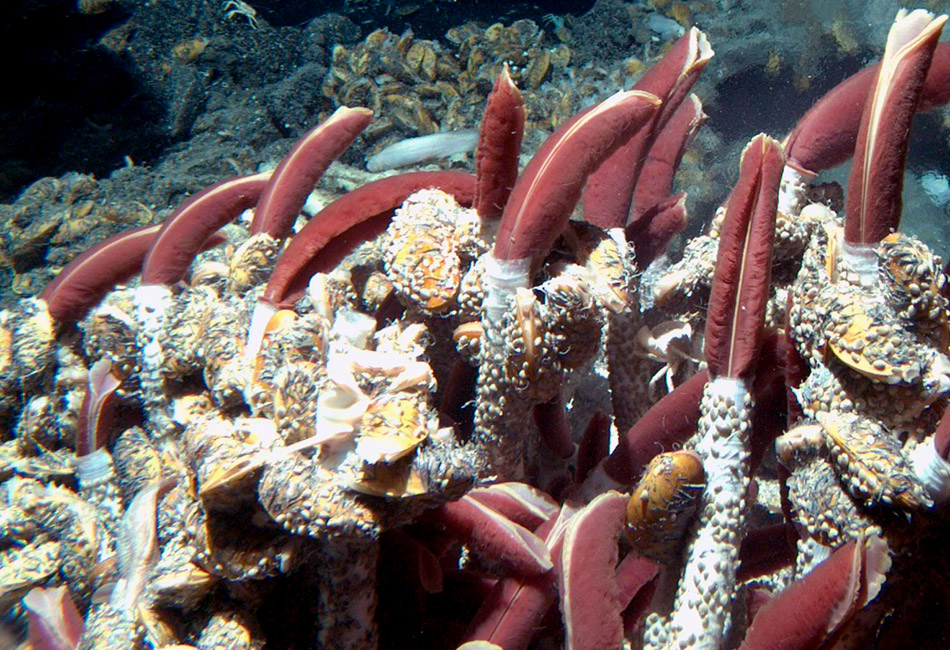
A well-developed ecosystem at a hydrothermal vent in the Pacific Ocean includes tubeworms (with the red plumes) and mussels (the yellow shellfish). 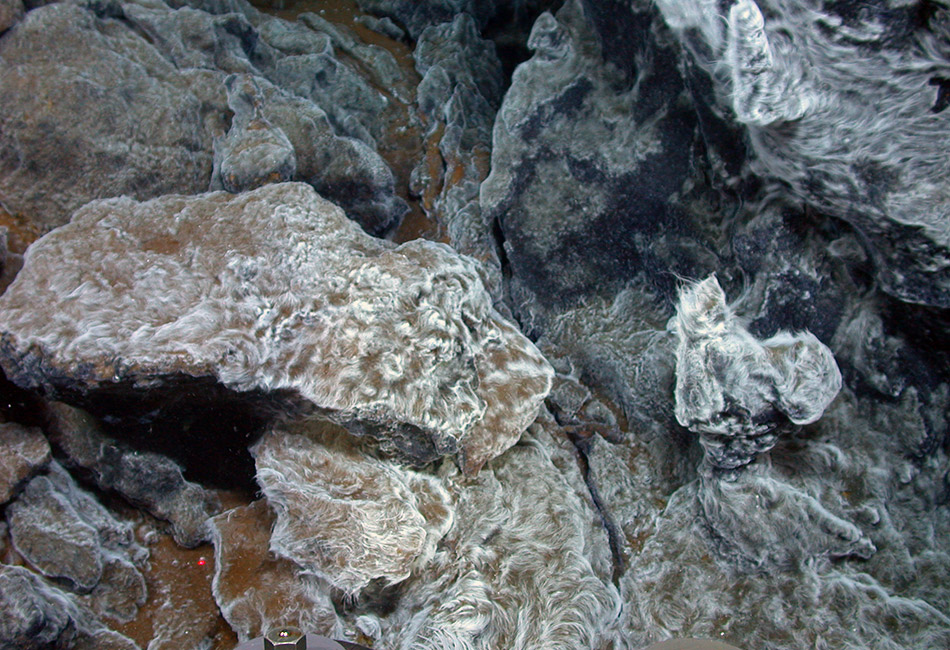
The fluffy white stuff on these rocks is biofilm made of millions of bacteria and the gooey slime they produce. Bacteria are the first organisms to colonize the area around a new hydrothermal vent. 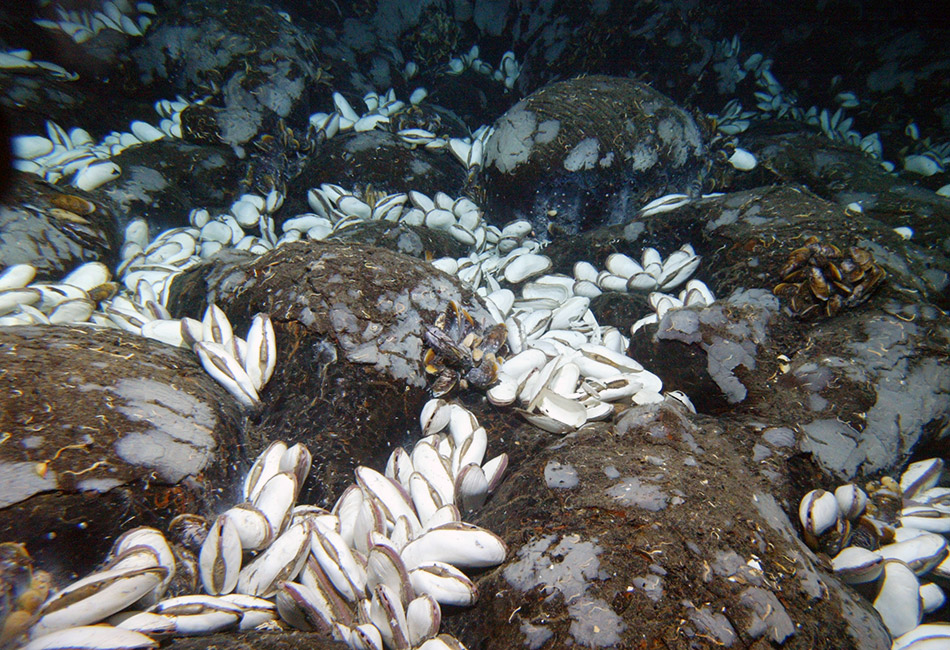
White clams and yellow mussels come later, sticking to the rocks near a vent with the help of dark patches of biofilm. 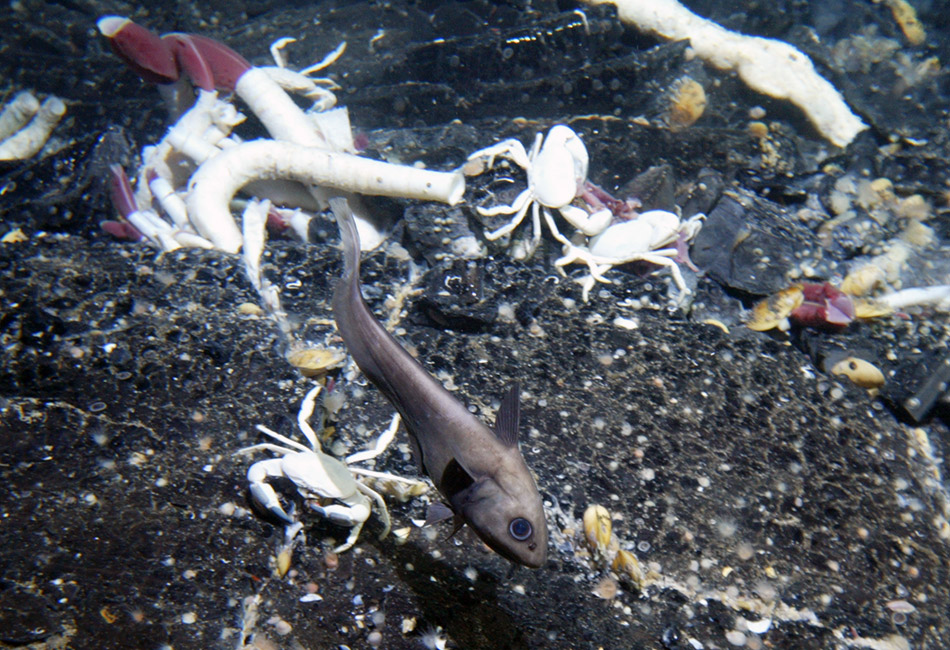
Hydrothermal vents are home to many kinds of animals, including tubeworms, crabs, mussels, and zoarcid fish. 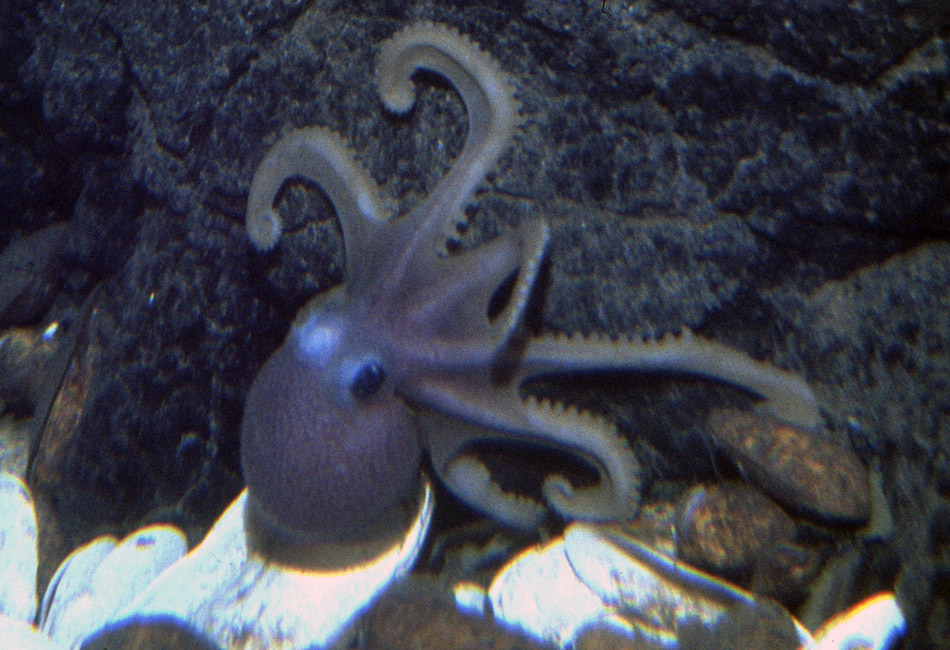
The octopus is one of the top predators in hydrothermal vent ecosystems. 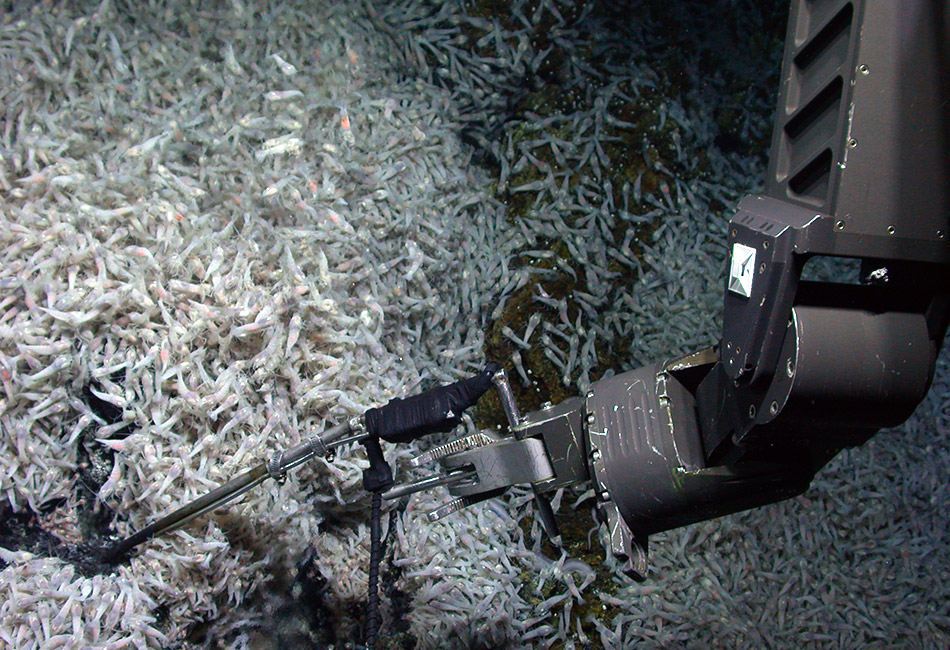
Most hydrothermal vents on the Mid-Atlantic Ridge don’t have tubeworms, but they do have shrimp, many of which host symbiotic bacteria. 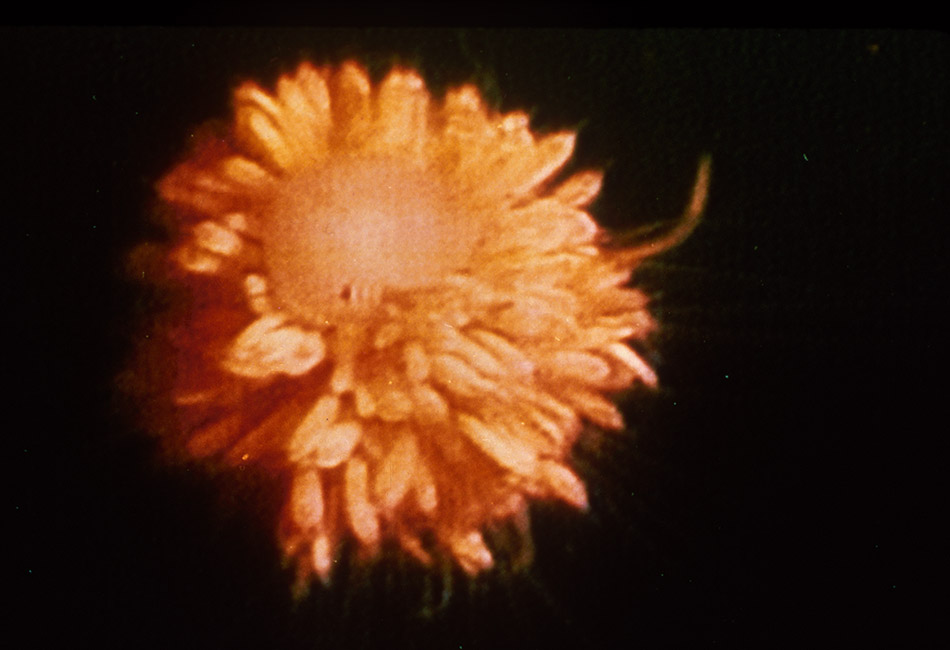
Each “petal” on the sea dandelion is an individual organism related to jellyfish. Sea dandelions survive by scavenging dead material. They are among the last animals to join a hydrothermal vent ecosystem and are a sign that the vent is slowing down. Deep-sea hydrothermal How can such a large variety of life exist in total darkness? The organisms that make up a vent ecosystem may seem strange and exotic, but the roles they play are very similar to the roles that other species play in ecosystems on land. Vent ecosystems also go through stages of development, or succession, like ecosystems on land. An ecosystem starts with a handful of species colonizing, or settling down, in a barren environment. A hydrothermal vent ecosystem forms after a volcanic eruption at the seafloor. One area of hydrothermal vents, called “9 North” because it is located at 9°N on a mid-ocean ridge in the eastern Pacific Ocean, has undergone two periods of eruptions recently, one in 1992 and one in 2005-06. Scientists carefully observed what happened in the months and years after those eruptions. The following description is based mainly on those observations. When an underwater volcano spews out lava, it creates a fresh rocky surface where nothing lives. Cold seawater seeps down into cracks and pores in the rock and mixes with minerals there. As the seawater is heated by volcanic activity deep below the surface, it becomes more buoyant (less dense) and begins to rise. It is laden with reduced chemicals such as hydrogen sulfide that formed by interactions between seawater and rock at the high pressures and temperatures of the vent environment. In some places the hot hydrothermal fluid shoots out of the seafloor like an undersea geyser. In other places, it mixes with more cold seawater and flows out of the seafloor more gently and over a wider area. This is called diffuse flow. The hydrothermal fluids in diffuse flow are warmer than seawater, but much cooler than the fluids that gush out of vent “chimneys.” This is where vent life flourishes the most. As diffuse-flow fluid moves up through the rock, it brings with it bacteria and archaea that normally live within tiny cracks and crevices below the ocean floor. Once the microbes reach the ocean floor, they start to colonize the area. This process begins within days of a volcanic eruption and continues as long as the vents are active. These single-celled organisms are the primary producers that form the base of the food chain at deep-sea vents, just like plants do on land and algae and cyanobacteria do in the sunlit parts of the ocean. Unlike plants, which get their energy from sunlight through photosynthesis As the bacteria multiply, they create a slimy substance that helps them stick to the rocks. This combination of microbes and slime is called a biofilm Biofilms may help the larvae of vent animals stick to the seafloor. They also serve as food for a variety of organisms. Protists, small invertebrates such as amphipods, and crabs arrive soon after the eruption and begin to graze on the microbes. Certain kinds of bacteria contribute to the ecosystem in a different way—by living in or on animals and providing their hosts with nourishment. Many vent animals have evolved a special partnership, or symbiosis Tubeworms, for example, don’t have a mouth or a stomach. Instead, they use special organs called trophosomes to house millions of symbiotic bacteria inside their bodies. Those organs provide a safe habitat for the microbes, and the worm’s blood supplies them with chemicals from the hydrothermal vent fluid that they need to survive. As the microbes harvest energy from the chemicals, they also make sugars and other nutrients that the worms can consume. At 9 North, a small species of tubeworm called Tevnia appears at the vents within a few months after a volcanic eruption. Within a couple of years, they are replaced by the giant tubeworm, Riftia. Mussels and clams are late colonizers at hydrothermal vents. These shellfish gather around cracks in the seafloor, where the biofilm may help them stick to the rocks. The mussels and clams in vent communities form symbiotic relationships with bacteria that live in their gills and use chemosynthesis to produce sugars and other compounds. The shellfish then use those compounds as food. The mussels can also filter bacteria out of the water to use as food. This enables them to survive for a time even in declining vent ecosystems, where their symbiotic bacteria may not gather enough energy through chemosynthesis. As more and more animals colonize the site, the vent ecosystem begins to attract predators, animals that feed on other animals. The vent ecosystem’s top predators are species such as octopus and Zoarcids, two-foot long fish that eat everything from tubeworms to crabs. Just like on land, when an animal dies at a hydrothermal vent, its body is eaten by scavengers or decomposed by bacteria. Waste material—poop—is also degraded by bacteria. In decomposition, the organic matter that made up the dead animal or poop is broken down into its basic nutrients. Those then are available for re-use by other organisms. It’s the original recycling! Some species eat both live and dead material. Crabs graze on microbes, prey on live clams and amphipods, and can also be scavengers. Other species, like sea dandelions, get their food exclusively from scavenging. Sea dandelions are fuzzy-looking balls made up of many individual animals that are related to jellyfish. They use long, whisker-like tentacles to anchor themselves on rocks, move around, and find food. Sea dandelions are some of the last to arrive at a vent site. If there are a lot of dandelions around, it usually means that those vents are no longer active and most of the other animals in the area are dying. Vent ecosystems elsewhere have some different species than are found at Pacific vents. For example, most vents found in the Atlantic Ocean do not have tubeworms, but they do have huge swarms of shrimp that gather along the sides of active vent chimneys to feed on bacteria that live on the rock and in the water. Many also have chemosynthetic bacteria as symbionts. Although vent ecosystems in different places often have different species, they all have organisms that perform the key functions of any ecosystem—primary producers, grazers, predators, and recyclers. Explore more using our interactive below
|
Mailing List | Feedback | Glossary | For Teachers | About Us | Contact
© 2013 Dive and Discover™. Dive and Discover™ is a registered trademark of Woods
Hole Oceanographic Institution
